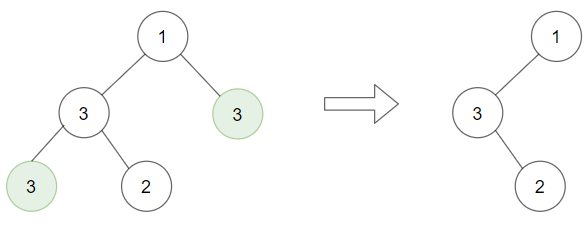Given a binary tree root and an integer target, delete all the leaf nodes with value target.
Note that once you delete a leaf node with value target, if it’s parent node becomes a leaf node and has the value target, it should also be deleted (you need to continue doing that until you can’t).
Example 1:

Input: root = [1,2,3,2,null,2,4], target = 2 Output: [1,null,3,null,4] Explanation: Leaf nodes in green with value (target = 2) are removed (Picture in left). After removing, new nodes become leaf nodes with value (target = 2) (Picture in center).
Example 2:

Input: root = [1,3,3,3,2], target = 3 Output: [1,3,null,null,2]
Example 3:

Input: root = [1,2,null,2,null,2], target = 2 Output: [1] Explanation: Leaf nodes in green with value (target = 2) are removed at each step.
Example 4:
Input: root = [1,1,1], target = 1 Output: []
Example 5:
Input: root = [1,2,3], target = 1 Output: [1,2,3]
Constraints:
1 <= target <= 1000- The given binary tree will have between
1and3000nodes. - Each node’s value is between
[1, 1000].
Solution:
/**
* Definition for a binary tree node.
* function TreeNode(val, left, right) {
* this.val = (val===undefined ? 0 : val)
* this.left = (left===undefined ? null : left)
* this.right = (right===undefined ? null : right)
* }
*/
/**
* @param {TreeNode} root
* @param {number} target
* @return {TreeNode}
*/
var removeLeafNodes = function(root, target) {
if (root === null) return null;
root.left = removeLeafNodes(root.left, target);
root.right = removeLeafNodes(root.right, target);
// return null to remove that leaf
if (root.val === target && root.left === null && root.right === null) {
return null;
}
return root;
};